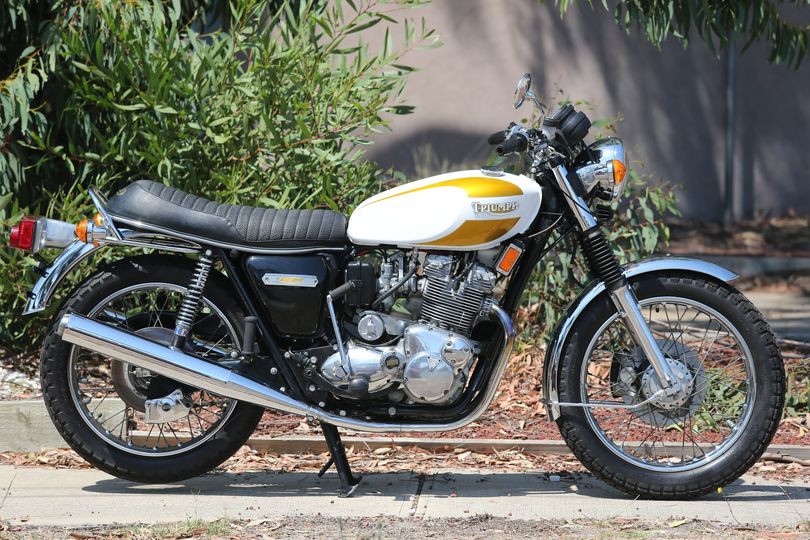Motorcycle Investor mag
Subscribe to our free email news
Triumph T160
(by Ian Falloon, Mar 2022)

This one
bike summed up the Brit motorcycle industry of the
1970s
If any one motorcycle sums up
the troubles and tribulations of the British motorcycle
industry in the early 1970s it is the Triumph Trident
T160. The T160 epitomised the dubious British motorcycle
manufacturing tradition of continually updating of
existing designs instead of designing something new.
With genetic DNA harking back
to Edward Turner’s Speed Twin of 1937, it was Triumph’s
last gasp before sliding into oblivion in May 1977.
Although BSA/Triumph was
taken over by Norton Villiers in 1973 the British
motorcycle industry, and indeed British industry as a
whole, was in deep trouble. With the Conservative
government seeking economic salvation through
encouraging exports Norton Villiers devoted their
attention to developing the Triumph Trident and Norton
Commando into US-friendly motorcycles. Basically this
meant incorporating an electric start, left side
gearshift, and quieter mufflers.
With the Honda 750 setting a
new benchmark Triumph had been experimenting with an
electric start on the Trident since 1969. But the
stumbling block was always the lack of room above the
gearbox. Using the inclined cylinder block of the BSA
Rocket 3 solved this problem nicely, and the Lucas
starter motor sat comfortably above the five-speed
gearbox.
A new frame was required to
accommodate the larger battery and although Triumph did
consider a more conventional duplex style frame,
ultimately the T160 ended with a traditional Triumph
single downtube frame. A longer swingarm, and shorter
front fork kept the wheelbase to a moderate 1470mm.
The three-cylinder engine was
much as before, with a 67 x 70mm bore and stroke
displacing 740cc, a 9.5:1 compression ratio, and a bank
of three 27mm Amal concentric carburettors. A larger
moulded airbox with paper filter element ensured the
intake roar was more subdued, and the new quieter
exhaust system included annular-discharge silencers.
The exhaust header pipes were
also quite different, a central Y-manifold splaying the
front downtube to look like four pipes. The quieter
intake and exhaust apparently didn’t hurt the T160,
which produced 58 horsepower at 7250rpm.
New for the T160 was a
left-side gearshift using a crossover shaft, and a
duplex primary drive chain instead of the previous
triplex unit. Not so new was the ignition, which was
still by a trio of contact breakers and three six-volt
coils powered by a ballast resistor.
Although the overhead valves
were still operated by pushrods and rockers, a new
tappet adjuster (copied from the Ducati 860)
incorporated a captive ball and obviated the need for a
bent feeler gauge to check valve clearances.
Other modern updates included
a rear 250mm disc brake, the same size as the front and
with an identical Lockheed caliper, a more modern
warning light panel between the Smiths instruments, and
a traditional teardrop fuel tank.
There was no denying the T160
was a handsome beast, with performance and handling to
match. Still rolling on vintage style 19-inch wheels the
T160 may have been a little heavy at 2had29kg dry but
it surprisingly good handling and was nimble. It
also had a fair turn of speed; topping out around 200
km/h.
Fuel consumption wasn’t a
strong point. Considering the oil crisis of 1974 was
still in recent memory this was another nail in the
coffin for Triumph.
Ultimately a nimble,
good-looking, electric start Trident with disc brakes
wasn’t enough to ensure its success, particularly in
America, Triumph’s traditional export market. The T160
still suffered quality issues and by 1975 a 750cc
pushrod triple was an anachronism in a world of double
overhead camshaft fours.
Although NVT considered a
1000cc four-cylinder Quadrant, and a Trident engine in
an Isolastic Commando chassis, by May 1977 the Trident
was history.
The rights for the Triumph
name were sold to the Meriden Cooperative, and when
forced into closure in 1983 they sold the manufacturing
rights to Triumph enthusiast John Bloor. The Triumph
triple was resurrected, but that is another story.
-------------------------------------------------
Produced by AllMoto abn 61 400 694 722
Privacy: we do not collect cookies or any other data.

Archives
Contact





